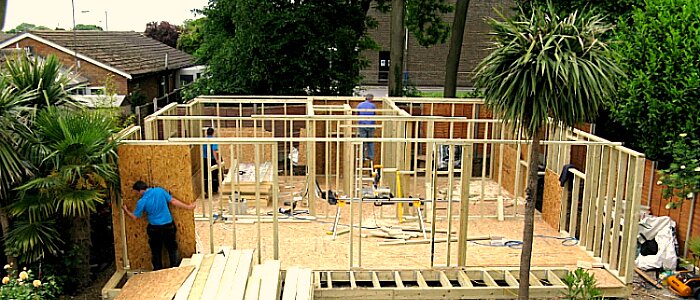2nd August 2011

There is an on-going discussion within the construction industry between traditional brick + block houses and Timber-Frame Houses and which style is more advantageous. Here we aim to summarise the key advantages of timber-frame builds.
So, Why Timber-Frame?
- Timber-Frame buildings have been around for hudreds of years, and in certain parts of the world they have become the norm, with an estimated 70% of the world’s population from developed countries being housed in them. In U.S.A and Canada it has been reported that timber-frame housing accounts for as high as 90% of the housing.[1]
- In the UK these figures are lower than the worldwide averages - 24.4% (average of 17% in England) however, it is currently the fastest growing method of construction in the UK.[1] Whether it is a garden building, commercial project, extension or home here we outline the main reasons behind this:
- Timber is one of the most sustainable and green building components available worldwide. The energy to produce materials such as steel or concrete is immense in comparison to that of timber. It is the only truly renewable building resource, and at in.it.studios, all our timber is sourced from sustainable and accredited schemes such as PEFC and FSC.
- Timber-frame buildings have a higher suitability to colder climates, such as the UK’s. They are more energy-efficient than other construction materials providing a comfortable temperature year-round and saving money on further insulation and heating costs.
- One of the main reasons for the vast difference between North American and British percentages shown above is mainly down to the availability of local resources and how this dictates the local building construction (vernacular architecture). In the UK, more readily available building materials such as brick, stone, granite and clay have been the choice of construction down to varying factors such as cost and accessibility. North America has had more access to available forestry and therefore seen a different type of architectural style develop over the years. However, things are changing and as the world has become a smaller place due to cost effective international shipping, the abundance of materials available is now staggeringly larger. As such, in conjunction with progression in technology, a better understanding, development in protective membranes, wood preservatives and treatments as well as a host of other advances have helped re-emerge timber-frame buildings back into the UK market.
- On average timber-frame builds take 20% less construction time[1], than their brick counterparts, saving on labouring costs and causing less disruption to the local area.
- A timber-frame build, like an in.it.studio can be weather-tight in as little as 4 days.
- Contrary to popular belief, Timber performs well in Fire tests and unlike other forms of construction i.e. steel, does not bend or flake at high temperatures.
- Finally... They look great!
Here are some quotes from the media:
“The audience is always biggest when we have a timber building” says the presenter, Kevin McCloud (Grand Designs)
“Timber frame construction is contributing to the drive to provide people with good, modern homes of proven sustainability and efficient construction. It also serves my Government’s aims of reducing CO2 emissions.” Rt Hon Nick Raynsford MP Minister
For information on contemporary sustainable timber-frame builds which can be used for a variety of purposes ranging from (guest) homes, extensions,
garden rooms and commercial properties
click here
[1] Facts and Figures from UKTFA.